#James Noël
Photo
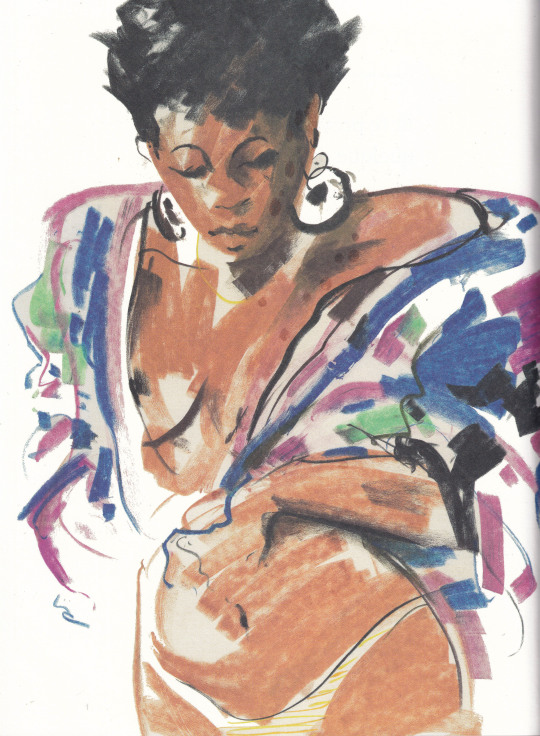
James Noël, illustration Zaü - Les algues de ta chevelure
Ta chevelure
boucle de nuit
dessine des paysages
pour mes mains
je dis algues
et la mer tremble
rougit
d'un bleu profond
ressac des caresses
mises à sac
par les navires de ton sang
je dis algues
tu divagues
dans ma bouche
unie au désordre fertile
de tes cheveux
37 notes
·
View notes
Text
Les Journées Poët Poët: inizia il festival!
Inizia oggi, mercoledì 15 marzo, il 17º festival di poesia «Les Journées Poët Poët, la poësie dans tous ses états d’art»: 12 giorni di festival e 24 eventi, a Nizza e in altri centri del dipartimento delle Alpi Marittime, in Francia, a partire dal tema nazionale del «Printemps des poètes»: le frontiere.
Conosco questa iniziativa attraverso il poeta Gabriel Grossi e il suo blog Littérature Portes…

View On WordPress
#15-26 mars 2023#15-26 marzo 2023#frontières#frontiere#Gabriel Grossi#Gwenn Masséglia#immigrazione#James Noël#L&039;humanité avant toute chose#la poësie dans tous ses états d&039;art#Les Journées Poët Poët#Littérature Portes Ouvertes#Marina Skalova#poesia#Raphaël Zweifel#Rémy Masséglia#Sabine Venaruzzo#Salpy Baghdassarian#Wilfrid Houssin
0 notes
Text

Merry Christmas / Joyeux Noël / Fröhliche Weihnachten / Feliz Natal / Buon Natale.
James Dean with his cousin Marcus - ph. Dennis Stock, Magnum Photos. - source Moto Vitelloni - Wheels n' wings.
63 notes
·
View notes
Text

ch. 1 of my christmas fic!
it’s jegulus with some side of wolfstar <3
#i really was gonna wait until i had more than 1 chapter written to post it#but i got too excited#so now you have this#i’m exited it’s overall a very cute fic#i hope you enjoy it too 😣#fic: reste jusqu’à noël avec moi#james potter#regulus black#jegulus#jegulus fic#james x regulus#starchaser#sunseeker#marauders#m writes
23 notes
·
View notes
Text










Le TVfilm Christmas on Cherry Lane (2023) avec l'acteurJames Denton.
Site Officiel -

1ère diffusion USA : 09 décembre 2023 sur Hallmark Channel
Première : 07 décembre 2023


Distribution : Catherine Bell, sa camarade de la série Good Witch (2015) ...


Captures

sources : @PinkSunsetxo et @LollyChristmas


Ses autres TVfilm Hallmark outre la série TV Good Witch (2015) :
- Les Témoins Amoureux (2022)
- Kiss Before Christmas (2021)
- For Love and Honor (2016)
- Paradis d’Amour (2014)

Autre TVfilm de Noël : Au secours je suis dans un film de Noël !


Alias Mr Lyle dans la série Le Caméléon
youtube
youtube
youtube
5 notes
·
View notes
Video
youtube
THE INCREDIBLE JESSICA JAMES (2017)
Grade: C+
Had some good scenes but overall could've been improved. Didn't like the subplot of her being a teacher with kids, threw the tone off from the adult relationships.
#The Incredible Jessica James#2017#C#Comedy Films#Netflix Films#Jim Strouse#New York#Dating#Breaking Up#Jessica Williams#Chris O'Dowd#Noël Wells#LaKeith Stanfield#Will Stephen#Taliyah Whitaker#Zabryna Guevara#Eric Loscheider#Evander Duck Jr.#Susan Heyward
1 note
·
View note
Note
Hi! I wanted to ask if Noël Coward was visual inspiration for your posh tiger character Chaucer? I know there’s lots of other people and characters who fit that specific flamboyant, well-dressed, early to mid 20th century, british vibe, but Coward was definitely the first person that popped into my mind when I saw him.
Though idk if your tiger guy is british. He just gives that energy lol
No, he wasn't, but thank you for further inspiration !
If I had to pin any human influence onto Chaucer, it would be James Mason ( voice claim ). So you are correct, Chaucer does indeed have a British accent. Perhaps a little more clipped than Coward's but just as elegant.
Chaucer is also prone to pronouncing words like down as 'dine', town as 'tine' and pound as 'pind'. Much like Frank N Furter from RHPS. I'm not entirely sure which specific British dialect that is but Tim Curry labelled it as the accent of a 'Belgravia Hostest with the Mostest', so we'll go with that.

#All that being said ; you're free to imagine Chaucer with any sort of voice !#Trashtalk#Verilydigital#Chaucer Klaue
134 notes
·
View notes
Text

222aghoststory & colinodonoghue1:
🚨 MEET YOUR DUBLIN CAST 🚨
@shonabmx @birdspotting @colinodonoghue1 @thewhitmore will be taking #222AGhostStory to Dublin’s @3olympiatheatre this Summer, 21 June - 11 Aug. For a strictly limited run 🚨Do you dare to join us? Book your tickets now! Link in bio 👻📸 @seamusphoto
Colinodonoghue1: Woohoo!! So excited to be a part of this show!!

[Get your tickets here!!!]
Runaway Entertainment in association with 3Olympia Theatre presents
2:22 - A GHOST STORY
Shona McGarty, Jay McGuiness, Colin O’Donoghue, Laura Whitmore,
Announced for The Very Special, Standalone Irish Production
The smash hit play by Danny Robins Makes Irish Debut At 3Olympia Theatre This Summer
For a Strictly Limited Run
Directed by Matthew Dunster & Isabel Marr
“A slick, chilling, romp of a play” The Guardian
‘A modern classic’ Sunday Times
Producer Runaway Entertainment is delighted to announce the stellar cast for the critically acclaimed, smash hit, supernatural thriller 2:22 - A Ghost Story opening at Dublin’s 3Olympia Theatre this summer for its debut Irish performances.
Shona McGarty (Eastenders) will play Jenny, Jay McGuiness (The Wanted, BIG! The Musical, Rip It Up), who is currently on the UK tour in 2:22 - A Ghost Story, will play Ben, Colin O'Donoghue (Once Upon A Time, The Tudors, The Right Stuff, The Gray House) will play Sam with Laura Whitmore (Love Island, Finding Joy, Queenie, and Jenny in 2.22: A Ghost Story in her West End debut) stepping into the role of Lauren.
The very special, standalone Irish production, produced for Dublin’s 3Olympia Theatre, will open on Thursday 20th June 2024 with performances until Sunday 11th August 2024 - for a strictly limited run only.
Full list of performances below. Age Suitability: 12+
Tickets priced from €26.50 including booking fee and €1.50 restoration levy on sale now with Ticketmaster Ireland
2:22 - A Ghost Story began in summer 2021 at the Noël Coward Theatre, starring Lily Allen, Julia Chan, Hadley Fraser and Jake Wood, and where it won the WhatsOnStage award for Best Play. It then transferred to the Gielgud Theatre for 10 weeks from 4 December 2021. The production there starring Stephanie Beatriz, James Buckley, Elliot Cowan and Giovanna Fletcher completed its run on 12 February 2022. For the first season at the Criterion (May - September 2022) the cast was Tom Felton, Mandip GIll, Sam Swainsbury and Beatriz Romilly. In late September Laura Whitmore, Matt Willis, Felix Scott and Tamsin Carroll took over.
The box office record-breaking run at the Lyric starring Cheryl, Jake Wood, Scott Karim, and Louise Ford, concluded its run on 23 April. The West End season at the Apollo Theatre starred Sophia Bush, Frankie Bridge, Ricky Champ, Clifford Samuel and Jaime Winstone, and set off on its UK tour in Autumn 2023 with Joe Absolom, Charlene Boyd, Nathaniel Curtis and Louisa Lytton in the cast. Current cast on the UK tour: Vera Chok (Lauren); Jay McGuiness (Ben); George Rainsford (Sam); Fiona Wade (Jenny).
2:22 is written by award-winning writer Danny Robins, creator of the hit BBC podcast The Battersea Poltergeist, and is directed by Matthew Dunster and Isabel Marr; it’s an adrenaline-filled night where secrets emerge and ghosts may or may not appear…
Danny Robins said: ‘I'm really looking forward to seeing how Dublin audiences respond to 2:22 this summer. The tour continues to be a great success and I can't think of a better place to round off the journey in 2024 than here with a brand new cast to be announced soon!'
What do you believe? And do you dare discover the truth?
“THERE’S SOMETHING IN OUR HOUSE. I HEAR IT EVERY NIGHT, AT THE SAME TIME"
Jenny believes her new home is haunted, but her husband Sam isn’t having any of it. They argue with their first dinner guests, old friend Lauren and new partner Ben. Can the dead really walk again? Belief and scepticism clash, but something feels strange and frightening, and that something is getting closer, so they’re going to stay up... until 2:22... and then they’ll know.
2:22 - A Ghost Story features set design by Anna Fleischle, costume design by Cindy Lin, lighting design by Lucy Carter, sound by Ian Dickinson for Autograph Sound and illusions by Chris Fisher. Casting by Matilda James.
2:22 - A Ghost Story is produced by Tristan Baker and Charlie Parsons for Runaway Entertainment, Isobel David and Kater Gordon. [source]
#colin o'donoghue#twitter#instagram#theatre#shona mcgarty#laura whitmore#jay mcguiness#3OLYMPIA THEATRE#Sam#2:22 a ghost story#danny robins#isabel marr#matthew dunster
46 notes
·
View notes
Text

Nicholas Shakespeare’s elegant biography of the James Bond author Ian Fleming takes its subtitle from a journalist’s observation, quoted halfway through, that its subject was “for a moment of time, a complete man” while working for British naval intelligence in the second world war. Yet you can’t help read it as a promise to give the reader what was left out of previous biographies such as John Pearson’s crisp, more portable authorised life from 1966. And is there a claim, too, for the alpha male credentials of the man called “Flemingway” by his friend Noël Coward? Journalist, stockbroker, thriller writer and – like his famous creation – a playboy and 70-a-day smoker, who died of a heart attack in 1964 at the age of 56 after a plagiarism row over the origins of Thunderball, the ninth Bond novel.
After a dutiful account of how Fleming’s Scottish financier grandfather became a millionaire – later cutting Fleming and his brothers out of his will – Shakespeare gets going with his subject’s troubled boyhood in the shadow of his father’s death in the first world war. Family friends in Switzerland take his education in hand after hasty exits from Eton (hanky-panky with a woman) and Sandhurst (gonorrhoea). His exams aren’t good enough for the Foreign Office; an engagement to a Swiss lover ends amid maternal threats to cut off his allowance. He falls on his feet at Reuters – it was that kind of life – further honing his knack for a scoop at the Sunday Times, a handy source of contacts for his war work.
Testimony woven from diaries, papers and interviews gives the book a flavour of oral history. Shakespeare goes to great lengths – not least tracking down a 94-year-old veteran, the last surviving member of a covert commando unit that Fleming organised – to dispel the idea that Fleming’s service, occluded by state-sanctioned secrecy, was just “in-trays, out-trays and ashtrays”. The book’s first half puts the future author at the heart of military and journalistic history – a search for German weapons of mass destruction; the race to get an inside scoop on the Cambridge spies – as well as the bedroom shenanigans of the English well-to-do. (Shakespeare, who encourages us at one point to smile at the mention of a “germanely” named Nazi admiral, Assmann, shows his assumptions of his audience when he writes confidently of “that small, turn-of-the-century intellectual clique, the Souls”.)
Fleming may be “the man behind James Bond”, in the subtitle of Andrew Lycett’s 1995 biography, but Shakespeare’s project, you sense, is partly to say there’s more to him. Eager to prove Fleming’s interest beyond the reasons that will draw most of his readers to the book, he is almost comically insistent on the degree to which his subject was ahead of the curve. Not only might he have sparked the idea of creating the CIA – in a memo written when the US-UK special relationship was being forged – but he also came up with the idea of putting a Christmas tree from Oslo in Trafalgar Square.
As for the dozen Bond novels that poured out of Fleming after 1953’s Casino Royale – written in a month in his winter bolthole in Jamaica a year earlier – they were, in Shakespeare’s telling, essentially the literary expression of a midlife crisis accelerated by the encroachments of fatherhood and a faithless union as the third husband of Ann Charteris. They had got together with an affair that caused a high-society scandal during her previous marriage to the Daily Mail heir Esmond Harmsworth; she later cheated on Fleming with the Labour leader Hugh Gaitskell, who told him that the “sex, violence, alcohol” formula of the Bond novels was “to one who leads such a circumscribed life as I do, irresistible”.
Fleming, injecting the American dirt of Mickey Spillane’s Mike Hammer novels into the English thriller, launched 007 on what Shakespeare calls the “spam-munching gloom of Attlee’s Britain”, writing (Fleming told his publisher) in order to make “as much money... as possible” and to have “as much fun as I personally can”. Respectable sales rocketed when JFK took a shine to From Russia, with Love – and the movies were yet to come. While Fleming was self-deprecating – telling Raymond Chandler the Bond novels were “straight pillow fantasies of the bang-bang, kiss-kiss variety” – he was proud enough to greet the director of the first Bond movie, Dr No, by telling him: “So they’ve decided on you to fuck up my work.”
“Luck had to be accepted with a shrug or taken advantage of up to the hilt,” Bond thinks in Casino Royale; he sees luck “as a woman, to be softly wooed or brutally ravaged, never pandered to or pursued”. Squint enough and Fleming took some care to cast his main character in ironic light. Early in that novel, the reader gets a fly-on-the-wall thrill of watching fieldwork in action, with the scene of theatrical care Bond takes to ensure his hotel room isn’t being searched; but soon enough his French sidekick turns up to let Bond know his upstairs neighbours have been listening in to his every move.
In Shakespeare’s biography, the novels are mostly a source of supporting quotation – he doesn’t get bogged down in questions of what it means to read Bond now, confining himself to a remark on how his “cavalier treatment of women... carried the sexual climate of the Blitz into the austerity of the cold war, and was less modern perhaps than it was later cracked up to be”. And perhaps there’s no need for his defenders to overstate the case for Fleming’s novelistic subtlety. Bond has always been shaped by a collective amnesia that allows us to make him what we wish him to be at any given moment; when he parachuted into the Olympic opening ceremony with the queen, it was as the best of British, not as a connoisseur of (Fleming’s words) “the sweet tang of rape”.
The novels, in a way, are irrelevant to 007, but the course of history would surely have run otherwise had Fleming not had the foresight to change his protagonist’s name from the original “James Secretan” – Fleming’s typescript revision perhaps his most significant literary act.
Daily inspiration. Discover more photos at Just for Books…?
19 notes
·
View notes
Text

Fréquente une fille qui lit. Fréquente une fille qui dépense son argent dans les livres au lieu des habits, dont les placards débordent parce qu’elle a trop de livres.
Aime une fille qui possède une liste de livres à lire et une carte de bibliothèque depuis l’âge de douze ans. Trouve-toi une fille qui lit. Tu la reconnaîtras parce qu’elle a toujours un livre à lire dans son sac. Elle regarde avec admiration les livres rangés sur les étagères des librairies, s’émeut discrètement quand elle a trouvé le livre qu’elle cherchait.
Tu vois cette fille bizarre qui respire les pages des vieux livres dans les librairies d’occasion ? C’est elle, la lectrice.
Elle ne peut pas s’empêcher de respirer les pages des livres, surtout quand celles-ci sont jaunies et usées.
C’est celle qui lit en passant le temps dans le café au coin de la rue.
Si tu regardes sa tasse, tu remarqueras que la crème a complètement fondu, parce qu’elle est déjà complètement absorbée par son livre. Perdue dans le monde imaginé par l’auteur.
Assieds-toi. Peut-être te lancera-t-elle un regard, car la plupart des filles qui lisent n’aiment pas être dérangées. Demande-lui si elle aime son livre.
Propose-lui une nouvelle tasse de café. Dis-lui ce que tu penses vraiment de Murakami.
Demande-lui si elle a dépassé le premier chapitre de Fellowship. Comprends bien que si elle te dit qu’elle a compris Ulysses de James Joyce, elle dit ça juste pour avoir l’air intelligente. Demande-lui si elle aime Alice ou voudrait être Alice.
C’est facile de fréquenter une fille qui lit.
Offre-lui des livres pour son anniversaire, Noël et toutes les autres fêtes.
Offre-lui des mots, en poème et en chansons.
Offre-lui Neruda, Pound, Sexton et Cummings. Montre-lui que tu as compris que les mots sont de l’amour. Sache qu’elle connait la différence entre les livres et la réalité, mais que malgré tout, elle essayera quand même de faire que sa vie ressemble un peu à son livre préféré. Ce ne sera jamais de ta faute si elle le fait. Il faut qu’elle essaie. Mens-lui. Si elle comprend la syntaxe, elle comprendra que tu as besoin de mentir. Derrière les mots se cachent d’autres choses : des raisons, des valeurs, des nuances et des dialogues. Ça ne sera pas la fin du monde. Déçois-la. Parce qu’une fille qui lit sait que les déceptions précèdent toujours des sommets d’émotions. Parce qu’une fille qui lit comprend que toutes les choses ont une fin, mais qu’on peut toujours écrire une suite. Qu’on peut recommencer encore et encore, et rester le héros. Que dans la vie, il y a toujours un ou deux méchants. Pourquoi avoir peur de tout ce que tu n’es pas ? Les filles qui lisent comprennent que les gens, comme les personnages, peuvent évoluer. Sauf dans Twilight. Si tu trouves une fille qui lit, ne la laisse pas t’échapper. Si tu la retrouves à 2 heures du matin, serrant un livre contre elle et pleurant, prépare-lui une tasse de thé et prends-la dans tes bras. Tu la perdras sûrement pour quelques heures, mais à la fin, elle reviendra toujours. Elle parlera comme si les personnages du livre existaient vraiment, parce qu’ils existent toujours, l’espace d’un instant. Tu la demanderas en mariage dans une montgolfière. Ou à un concert de rock. Ou l’air de rien, la prochaine fois qu’elle sera malade. Par Skype. Tu souriras tellement que tu te demanderas pourquoi ton cœur n’a pas encore éclaté dans ta poitrine. Tu écriras l’histoire de vos vies, vous aurez des enfants avec des noms étranges et des goûts encore plus étranges. Elle fera découvrir le Chat Potté et Aslan à vos enfants, peut-être même les deux dans la même journée. Vous passerez l’hiver de votre vie en vous promenant ensemble, et elle récitera doucement Keats pendant que tu feras tomber la neige de tes bottes. Fréquente une fille qui lit, parce que tu le mérites.
Tu mérites une fille qui peut, par son imagination, parer ta vie de mille couleurs.
Si tu n’es capable de lui offrir que de la monotonie, des idées ternes et des demi-mesures, mieux vaut rester seul.
Si tu veux le monde entier, et tout ce qui se cache derrière, fréquente une fille qui lit.
Encore mieux, fréquente une fille qui écrit.
Rosemarie Urquico
14 notes
·
View notes
Text
❝𝘮𝘦𝘳𝘳𝘺 christmas, jamie, how i love you so 𝙢𝙪𝙘𝙝.❞
❝feliz navidad, reg,❞ james mutters against regulus' skin, drunk on alcohol and love. regulus sighs. he kisses james' forehead, pushing away hair cursed to be eternally untamed.
❝it's joyeux noël, jamie,❞ reg whispers.
❝i love you too,❞ james mumbles, already fallen asleep.
#james potter#regulus black#jegulus#starchaser#house of black#harry potter#the marauders#marauders#the marauders era#death eaters#merry christmas#a little early christmas present everyone hope you enjoy#drabble#idrownedforyou on twitter#brownsugalessice on instagram#tzhnn
33 notes
·
View notes
Text
Shoelaces

[Detail of the Meagre Company, oil on canvas, c. 1633-1637, by Frans Hals, via Wikimedia.]
While shoelaces had been fairly common in the 17th century by the beginning of the 18th century they had been surpassed in popularity by buckles.

[Detail of Declaration of Independence, oil on canvas, c. 1819, by John Trumbull, via Wikimedia.]
The most common style of men's shoe in the 18th century was black leather buckled shoes, typically with a small heel (see above). Even fashionable men often wore these simple black buckled shoes, though they may accessorise them with ornate buckles rather than plain ones. Even on men's high heels we see buckles replacing ribbons at the turn of the century.


[Left: Detail of Charles II of England, oil on canvas, c. 1670-1675, by Simon Pietersz Verelst, via Wikimedia.
Right: Detail of Louis XIV of France, oil on canvas, c. 1700-1701, by Hyacinthe Rigaud, via Wikimedia.]
During the first few decades of the 18th century shoe ties remained popular alongside buckles in women's footwear. However extant examples of buckled shoes outnumber those of laced shoes, though this may in part be due to shoes being converted to accommodate the fashionable buckle.

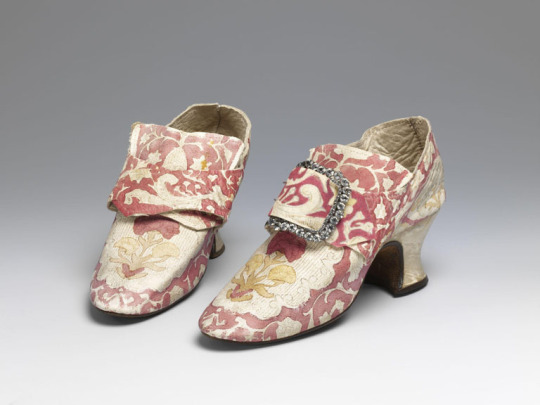
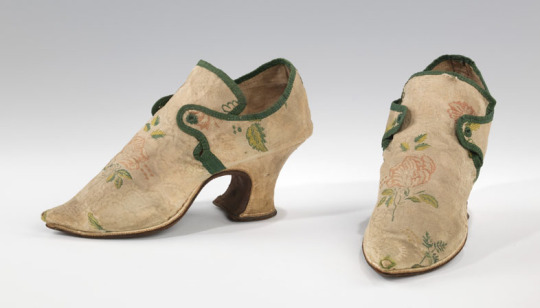
[Left: Shoes with ribbon ties, leather & brocaded silk, c. 1730s, via V&A (accession number: T.197&A-1927).
Middle: Buckled shoes, painted kid leather & silk, c. 1760s, via V&A, (accession number: 270&A-1891).
Right: Shoes with eyelets, leather & silk, c. 1700–1720, via The Met (accession number: 2009.300.1480a, b).]
In their description for the shoes on the right the Met writes:
Most aficionados of historic fashion are well acquainted with 18th century ladies' shoes in the classic buckled latchet style, as they survive in fairly good number. The predecessor of these - latchet ties shoes - are however fairly scarce in good unaltered condition. In order to extend their life as fashionable footwear, latchet tie shoes were frequently modified to accommodate a buckle.
By the 1780s shoe strings in menswear was so unpopular in mainstream Parisian fashion they were seen of being indicative of sodomy. In his article Commissioner Foucault, Inspector Noël, and the “Pederasts” of Paris, 1780-3 Jeffrey Merrick explains how Foucault and Noël used men's clothes to identify them as suspected sodomites. These men wore “some combination of frock coat, large tie, round hat, small chignon, and bows on the shoes.” Merrick speculates that these men were using fashion to signal to each other. Understandably when questioned by police men would deny such a purpose.
In England men who wore shoe strings were seen as effeminate. In their issue of 6-9th of December 1788 the St. James's Chronicle or the British Evening Post describes the "Jessamy or Petit-Maitre" (both terms for effeminate men) as follows:
The Jessamy or Petit-Maitre are so nearly allyed that the Rules that serve for one will do for the other-These He-She Beings should always take particular Care in the Decoration of their sweet Persons-Their Clothes should be cut to the very extreme of the Mode, their Hair dressed particularly nice, even if they sit two Hours under the Hairdresser's Hands, and while under the Operation, are to take out their Pocket Glass and give the Hair Dresser Instructions form Time to Time-When they walk the Streets of London, they are to make short Steps, as was formerly the Fashions of the fine Ladies, wear Shoe-Strings-paint their Faces, and be alarmed at every little Noise they hear in the Streets. In short it will be necessary to keep up their Reputation that they assume a Behaviour more feminine than masculine-and by all Means to imitate the Behaviour and Looks of the Females in the Days of their Great Grandmothers. Such Conduct will stamp their Characters in the Eyes of their Brethren.

[Sir John Coxe Hippisley, oil on canvas, c. 1779–80, by William Pars, via Art & the Country House.]
However by the late 1780s shoe strings were already starting to have a resurgence, in part due to their cost. With shoe strings being cheaper than buckles many men started to adopt them in spite of the associations with effeminacy. On the 21st September 1786 The Times reported:
The shoe-strings are now the fashion wit all the barbers boys, hair-dressers, and waiters, in London. The charity schools have also adopted them, as they are much cheaper than buckles. A man of sense, and a real man of fashion, has never yet dishonoured his instep with such a piece of mean folly.
And on the 12th of July 1787 The Times suggests that when a "tolerably well-dressed man wears them, the general conclusion is, that his buckles are in pawn." However in spite of the comparative cheapness of shoe strings the association with effeminacy persisted.
One intriguing instance of the cultural perception of shoe strings comes from a 1789 adaptation of the Tempest that opened on Drury Lane on Tuesday the 13th of October. The play included an epilogue written by General John Burgoyne. The epilogue fear-mongers the growth of effeminacy in England writing that "we may lack men, though over-run with males." Burgoyne depicts the middle class John Bull as an effeminate "He-Miss" Milliner:
Yet John sometimes his shape and sex degrades,
And stoops to rob his sisters of their trades.
Six feet in height, with sinews of an ox,
Shoulders to carry coals, and fists to box,-
Behold-O shame!-a thing of whip and hem-
A He-Miss Millener-"Your orders, Me'm?-
"Rouge, lipsalve, chicken gloves, perfumery,
"Hair cushions, gauzes, bustles?-HE! he! he!"-
Burgoyne then shifts to men "of higher bearing";
Still Falstaff's men, all radish and cheese-paring!-
Oh! could he sketch some figures that one sees-
Tied up with strings at shoes and strings at knees!
So thick the neck-cloth, and the neck so thin!
He'd swear they bore a poultice for the chin:-
And lest the cold the adjacent ears should harm,
See half a foot of cape to keep 'em warm;
While the stiff edge, for better purpose made,
Rubs off the whiskers it was form'd to shade.
With eyes of fire that vie with snuffs in sockets,
And hands distress'd for want of waistcoat pockets:
The crutch of levity directs their gait;
And wanghee bends beneath their wangling weight.
On the 14th The World praises the epilogue as a "pleasant satyr upon modern modes" noting in particular;
the perversion of his good parts into effeminate pursuits-the Man-Milliner-the strings at shoes, and strings at knees-the stiff stand-up cape, "chasing the whisker it was meant to hide"-the waistcoat pockets-were all perfection, in what is the Epilogue's best praise, knowledge of effect, and strong accomplishment of it.
In contrast to Burgoyne's depiction of him as a "He-Miss Millener" John Bull, a personification of England (much like Uncle Sam is to the US), was typically depicted as a plainly dressed middle class Englishman. Some satires such as James Gillray's Politeness would compare the masculine English John Bull to the effeminate French archetype. Bull is depicted sitting with his legs open, wearing blue, red and buff with short un-powdered hair and wearing boots. The Frenchman is sitting with his legs closed, wearing pink and green (colours that were considered effeminate) with white powdered hair tied back with a ribbon and wig bag. However he is wearing bucked shoes.
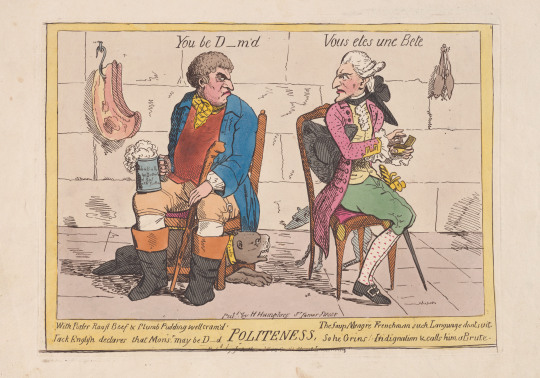
[Politeness, hand-coloured etching, c. 1779, copy after James Gillray, via The Met.]
Another example of a typical depiction of John Bull can be seen in The Honest Pickpocket published by William Holland which comments on the clock tax enacted by the Pitt government. The cartoon depicts Prime Minister William Pitt taking a watch out of John Bulls pocket. Pitt is saying "Don't be alarmed, Johnny, I only want to see whether it is Gold or Silver - you know there is a great deal of difference between Half a Crown and Ten Shillings."
In this anti-Pitt satire, Bull is depicted again in blue, red and buff with un-powdered hair, however this time he is wearing buckled shoes. Pitt in contrast is depicted in green with powdered hair tied back with a ribbon and wig bag. His shoes are fastened with strings.

[The Honest Pickpocket, hand-coloured etching, c. 1797, published by William Holland, via The British Museum.]
However in An Enquiry Concerning the Clock Tax Pitt is depicted in blue and red with buckled shoes. The satire is playing on a pun, the clock tax was a tax of the time keeping devices but in the 18th century stockings sometimes had decorative embroidery known as clocks. In the print a delegate "from the worthy and respectable Society of Hosiers" asks Pitt "to know whether your Honor means to extend the Tax to Clocks upon Stockings." In contrast to Pitt the hosier wears not only stockings with clocks, but also shoes with strings as well as breeches with strings at the knees. Pitt is holding a quill labeled "Tax Pen", he is halfway through writing a list of taxes which includes "Shoe Strings", "Knee Strings" and "Hair Strings".

[An Enquiry Concerning the Clock Tax, hand-coloured etching, c. 1797, after George Moutard Woodward, published by S. W. Fores, via The British Museum.]
While this satire was clearly playing on the pun, it's not too far off what some were proposing. With the popularity of shoe strings increasing during the 80s the buckle makers were starting to get concerned for their livelihood and hoped a shoe string tax would combat the price difference. On the 22nd of November 1788 The Times reported:
The buckle makers it is said intend to petition for a tax on shoe strings by an eighteen penny stamp on each pair. This, although somewhat extraordinary, yet is in agitation, and might be easily effected.
With most of the buckle manufacturing coming out of Birmingham it was reportedly a risky move to wear shoe strings there. On the 28th August 1789 the Oracle reported:
At Birmingham, the man who dares appear with ribband-ties in his shoes, is certain not to pass current. He is instantly seized, his shoes taken off and cut to pieces; and no shoe maker can dare to sell him a new pair, unless he buys a pair of buckles first!
Much of the public was on the side of the buckle makers and against the shoe strings. On the 12th August 1789 the Oracle bemoans that "thousands of His Majesty's loyal subjects are now starving, from the introduction of the effeminate fashion of shoe-strings." On the 6th of November the Oracle reported that on "being asked by a Nobleman, why he had such an objection to Shoe Strings-His Royal Highness replied in these emphatic words-"
In the first place, I dislike them, for they look effeminate, are neither genteel or becoming; but give a certain air of meanness to the foot, which should be avoided. In the next place, I do not wear them, for it shall never be said of me, that any whim of mine has been instrumental in bringing the hard labouring Mechanic to Ruin!
A letter signed "Cheapside" published on the 5th January 1789 in The World was a bit more extreme suggesting that men who wore shoe strings "ought, in plain English, and with a good sufficient English cord, to be hanged". While Cheapside was concerned that the buckle makers were being "tied up from getting their bread" the true dislike of shoe strings and the men who wore them seem to be more due the their "intimations" that were "most disgraceful to manhood."
#to my amerev followers yes its the same General John Burgoyne he became a playwright after the war#fashion history#queer history
56 notes
·
View notes
Text
Congratulations to Laura Donnelly has been nominated for Best Actress in a Play this year. The Olivier Awards 2024 is theatre’s most prestigious honour and has announced its nominations.
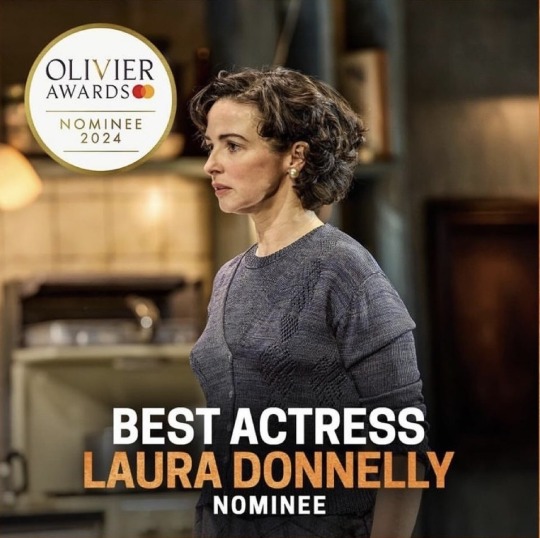
The Olivier Awards are recognised internationally as the highest honour in British theatre 🎭 equivalent to the BAFTA Awards for film and television, and the BRIT Awards for music.
Olivier Awards 2024: list of Best Actress nominations
-Laura Donnelly for The Hills of California at the Harold Pinter theatre
-Sophie Okonedo for Medea at @sohoplace
-Sarah Jessica Parker for Plaza Suite at the Savoy theatre
-Sheridan Smith for Shirley Valentine at the Duke of York’s theatre
-Sarah Snook for The Picture of Dorian Gray at the Theatre Royal Haymarket

Best new play
-Dear England by James Graham at the National Theatre – Olivier and Prince Edward Theatre
-The Hills of California by Jez Butterworth at the Harold Pinter theatre
-The Motive and the Cue by Jack Thorne at the National Theatre – Lyttelton and Noël Coward theatre
-Till the Stars Come Down by Beth Steel at the National Theatre – Dorfman
The competition for nominations has been fierce during an outstanding year for theatre with significantly more productions than last year. There has been a record-breaking number of new plays gracing the stage and a stunning array of on-screen stars treading the boards – including those in striking one-person performances, have stunned with their ground-breaking creativity.
The annual awards will take place on Sunday 14 April at the iconic Royal Albert Hall with a highlights package broadcast on ITV that evening.
@olivierawards @laurafdonnelly #bestactress #OlivierAwards2024 #TheHillsofCalifornia
Posted 6th April 2024
14 notes
·
View notes
Text
2023 in 12 movies (1 per months)
January
The Horse Whisperer (1998) directed by Robert Redford with Robert Redford, Kristin Scott Thomas, Scarlett Johansson, Sam Neil, Chris Cooper and Cherry Jones
[First Time]
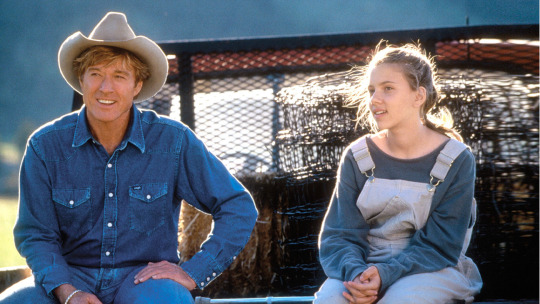
February
L'Horloger de Saint-Paul (1974) directed by Bertrand Tavernier with Philippe Noiret, Jean Rochefort, Jacques Denis, Yves Afonso, Julien Bertheau and Jacques Hilling
[First Time]

March
The Fabelmans (2022) directed by Steven Spielberg with Gabriel LaBelle, Michelle Williams, Paul Dano, Seth Rogen, Keeley Karsten, Julia Butters and Judd Hirsch
[First Time]
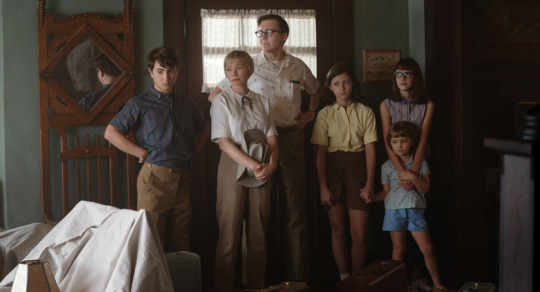
April
The Third Man (1949) directed by Carol Reed with Joseph Cotten, Alida Valli, Orson Welles, Trevor Howard and Bernard Lee
[First Time]

May
The World, The Flesh and the Devil (1959) directed by Ranald MacDougall with Harry Belafonte, Inger Stevens and Mel Ferrer
[First Time]

June
La ciociara (1960) directed by Vittorio De Sica with Sophia Loren, Eleonora Brown, Jean-Paul Belmondo, Carlo Ninchi, Andrea Checchi and Pupella Maggio
[First Time]
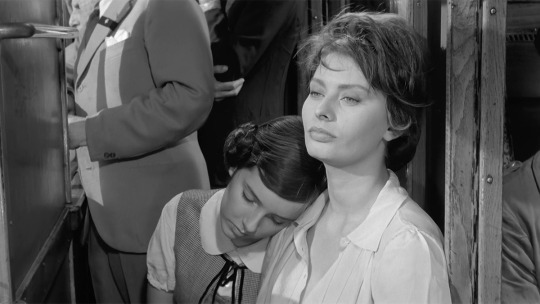
July
Oppenheimer (2023) directed by Christopher Nolan with Cillian Murphy, Robert Downey Jr., Emily Blunt, Matt Damon, Florence Pugh, Josh Hartnett and Casey Affleck
[First Time]
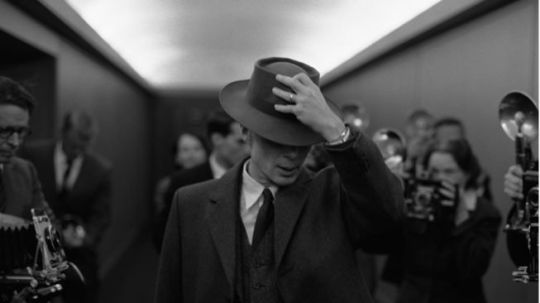
August
Heat (1995) directed by Michael Mann with Al Pacino, Robert De Niro, Val Kilmer, Tom Sizemore, Diane Venora, Amy Brenneman, Dennis Haysbert, Donald Breedan and Ashley Judd
[First Time]

September
Catch Me If You Can (2002) directed by Steven Spielberg with Leonardo DiCaprio, Tom Hanks, Christopher Walken, Nathalie Baye, Amy Adams, Martin Sheen, James Brolin and Brian Howe
[First Time]

October
Le Grand Bain (2018) directed by Gilles Lellouche with Mathieu Amalric, Guillaume Canet, Benoît Poelvoorde, Jean-Hugues Anglade, Philippe Katerine, Félix Moati, Alban Ivanov, Balasingham Thamilchelvan, Virginie Efira et Leïla Bekhti
[First Time]

November
Fools Rush In (1997) directed by Andy Tennant with Matthew Perry, Salma Hayek, Jon Tenney, Carlos Gómez, Tomás Milián, Siobhan Fallon et John Bennett Perry
[First Time]
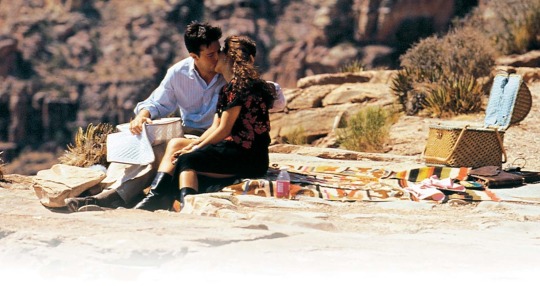
December
The Great Race (1965) directed by Blake Edwards with Tony Curtis, Natalie Wood, Jack Lemmon, Peter Falk, Keenan Wynn et Ross Martin
[First Time]

Honourable Mentions :
Airplane! (1980)
Duel (1972)
Les Sentiments (2003)
The Carpetbaggers (1964)
Scoop (2006)
Mon crime (2023)
To Have and Have Not (1944)
The Super Mario Bros. Movie (2023)
The Man Who Shot Liberty Valance (1962)
臥虎藏龍 (2000)
The Glenn Miller Story (1954)
Le Dernier Voyage (2020)
Dead Men Don't Wear Plaid (1982)
L'ingorgo (1979)
Indiana Jones and the Last Crusade (1989)
Adieu Gary (2008)
Conflict (1945)
Fahrenheit 451 (1966)
La Nuit américaine (1973)
Sorcerer (1977)
La Guerre des polices (1979)
Life of Pi (2012)
The Big Short (2015)
Le Hussard sur le toit (1995)
Excalibur (1981)
The Naked Gun: From the Files of Police Squad! (1988)
Bridget Jones’s Diary (2001)
Le Procès Goldman (2023)
Enter the Dragon (1973)
Matrimonio all'italiana (1964)
Chaplin (1992)
La Vie de château (1966)
Escape from Alcatraz (1979)
Au-delà des grilles (1949)
Second Tour (2023)
Le Couteau dans la plaie (1962)
The Eiger Sanction (1975)
JFK (1991)
Le Fugitif (1993)
Chef (2014)
Quai des Orfèvres (1947)
Appointment with Death (1988)
Bridget Jones: The Edge of Reason (2004)
Wallace & Gromit: The Curse of the Were-Rabbit (2005)
River of No Return (1954)
L'Assassinat du père Noël (1941)
Dances with Wolves (1990)
Die Glasbläserin (2016)
The Lion in Winter (1968)
Les Mystères de Paris (1962)
#2023 films#my top 12#cinema#cinematography#the horse whisperer#l'horloger de saint paul#the fabelmans#the third man#the world the flesh and the devil#la ciociara#oppenheimer#heat#catch me if you can#le grand bain#fools rush in#the great race#films#movies of 2023#bye 2023
11 notes
·
View notes
Text
What's in a Name? — Miraculous Ladybug
2. CÉSAIRE, LAHIFFE & BOURGEOIS
2.1. Césaire
Césaire: from a Roman cognomen probably meaning "hairy", which was most famously the name of Julius Caesar. Was most likely chosen in reference to Aimé Césaire, a Martinican author, poet, and politician.
Alya: "sky, heaven, loftiness", in Arabic. It's also the name of a star in the constellation Serpens, but that's neither here nor there. Is a reference to singer Aaliyah.
Marlena: a blend of "Maria" and "Magdalena", it was chosen in reference to Marlena Shaw.
Otis: a reference to Otis Redding. Is derived from the Germanic name "Otto", meaning "wealth, fortune".
Ella: reference to Ella Fitzgerald. It comes from either a Germanic word meaning "other", or from the shortening of various names beginning with "El-".
Etta: short form of Henrietta and other names that end with "-etta". Is a reference to Etta James, whose stage name was derived from her real given name Jamesetta.
Nora: probably a reference to jazz musician Norah Jones. Is either from a short form of Honora or Eleanor, or from an Arabic name meaning "light", the latter of which would etymologically connect her name with Nooroo's.
2.2. Lahiffe
Lahiffe: from an Irish surname that means "descendant of the hero". Together with the last syllable of Nino's name, it forms a pun: in French, "-no Lahiffe" sounds a lot like "Nolife", which was the name of a French TV network that focused on geeky topics.
Nino: diminutive of various Italian names that end with "-nino", like Antonino and Saturnino. Its spelling resembles that of the Spanish word "niño", meaning "child". It has gone way up in popularity in France, going from #431 in 1995 to #28 in 2022.
Chris: a shortening of various names that start with "Chris-", like "Christopher" and "Christian". Is the English translation of the character's French name, "Noël", which is literally just the French word for Christmas.
2.3. Bourgeois
Bourgeois: from an Old French word meaning "city dweller", which originally referred to the wealthier members of the Third Estate during the French Revolution. Might also be in reference to "parloir aux bourgeois", a very archaic French term meaning "city hall".
Chloé: from the Ancient Greek word meaning "sprout", which was an epithet of the goddess Demeter. In modern Greek, it has the much less glamorous meaning of "grass, lawn".
André: from an Ancient Greek word that simply means "man".
Audrey: "noble strength", in Old English, this name is where we get the word "tawdry". Audrey is the only member of the Bourgeois family whose first name is not Greek in origin.
Zoe: "life", in Greek. Not as in being a name that means "life", mind you, it's literally the Greek word for life.
Lee: from the Old English word for "meadow".
#everyone has these complex names and then there's andré#poor guy#up next: couffaine & tsurugi#series: what's in a name?#what's in a name: miraculous ladybug#miraculous ladybug#alya cesaire#nino lahiffe#chloe bourgeois#zoe lee
17 notes
·
View notes
Text

Santa Claus
Papá Noel
It originates from the French for Father Christmas: ‘Père Noël’.
They just translated the ‘père’ part, ‘noel’ not even being a Spanish word.
Why does Santa enter through the chimney? It is easier to use the door.
¿Por qué Papá Noel entra por la chimenea? Es más fácil usar la puerta.
Picture by James Vaughan on Flickr
#santa#santa claus#papa noel#Pere Noel#spanish#vocabulary#vocab#español#hint#mem#mnemonic#wotd#word of the day
7 notes
·
View notes